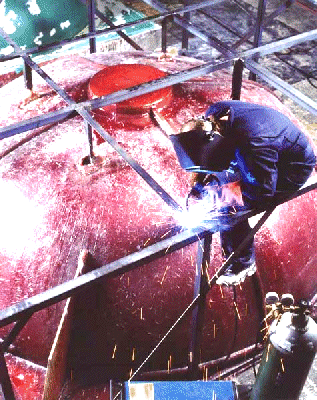
Tim Furniss/LONDON
THE world's First privately developed expandable medium-lift launch vehicle is to be offered by Beal Aerospace Technologies, of Dallas, Texas.
Beal will sell launches to low Earth orbit (LEO) of multiple payloads weighing about 7,710kg - "double the capacity" of the Boeing Delta II - "at a substantially lower price", says the company (which may have got its mathematics slightly wrong since the Delta II's LEO capacity is more than 5,000kg). Beal will not divulge its launch price - a Delta II commercial launch costs about $45-50 million.
Its BA-1 booster is being marketed to capitalise on the perceived market for LEO launches of fleets of mobile communications and "Internet in the sky" multimedia satellites. Beal also has its sights on geostationary transfer orbit (GTO), however. A more powerful vehicle, the BA-2, is already on the drawing board.
The company is part of Beal Financial, which is operated by Andrew Beal, a Dallas banker and property owner. He plans to invest up to $250 million in his project, has started building a new, purpose built, manufacturing plant and has chosen a launch site on a Caribbean island. He has already taken on more than 30 former Boeing, Lockheed Martin, NASA, Orbital Sciences and Thiokol employees for the project. Beal, it seems, means business.
Simplicity is the key to the Beal approach, to get into the market as quickly as possible. The BA-1 will be expendable - like all commercial boosters now available - although the market may soon be populated with low cost re-usable launch vehicles, if the Kistler Aerospace K-1 and other fledgling programmes are successful. These, in theory, should be able to offer a much lower price.
The BA-1 is a three-stage launcher, measuring 51.5m tall and 5m in diameter, with a large payload fairing affording room for side by side placement of satellites. The vehicle employs one kerosene/hydrogen peroxide engine per stage and weighs 498t at lift-off. The first and second stage engines use liquid injection thrust vector control, while the gimballed third stage engine can be restarted in orbit.
The third stage enables various orbits to be reached, including GTO, as well as Earth escape missions. The standard ascent trajectory reaches a 200km altitude to LEO. For Earth escape missions, the circular orbit is used as a parking/phasing orbit, while transfer orbit missions will have a perigee of 200km, with the apogee as the final planned orbit altitude. Upon reaching apogee, a second burn is executed by the third stage to circularise the orbit.
PAYLOAD PROJECTIONS
The payload projection contains a 60m/s flight performance reserve, a 200kg "avionics growth" reduction, a 5% margin, 20% burnout mass margins for each stage and a 3% specific impulse margin for each stage.
Payload to GTO is 2,645kg, into an orbit with inclination of 19.5°, based on a launch azimuth of 97°. This would place the BA-1 in the lower GTO league with China's Long March 3A, suitable only for small communications satellites such as a Hughes MS-376 bus.
The lightweight filament wound composite propellant tanks are being fabricated at Beal's existing factory using the "world's largest filament winding machines", it says. The company is using composite materials throughout its rocket programme.
Following a worldwide search for a launching area, Beal Aerospace has selected Sombrero Island in the Caribbean. This 40Ha (100acre) island is a perfect location for reaching LEO and GEO orbits, says the company. Sombrero measures 1.6km (1 mile) long by 0.6km across.
Beal signed a 98-year agreement in December 1997 for the exclusive use of Sombrero. This lone island is 56km north-west of Anguilla and is a dependent territory of the UK. It is ideally located for due-east launches as well as north and north east launches for all orbit inclinations of commercial interest. Primitive Sombrero has no residents and an extremely barren ecosystem, with little vegetation or animal life, the company says.
The island is to be transformed into the Beal Aerospace launch site. The changes will include the construction of a horizontal vehicle integration building on one end of the island and a launch pad at the opposite end. A runway will allow aircraft to transport personnel and high value cargo. A heavy-load roadway will link the integration building to the launch pad.
A small port area to the south west of the integration building will be used for transport of rocket stages, propellants, and heavy equipment and supplies via barge and ship.
The Beal Aerospace launch vehicle development programme is rapidly evolving, with production facilities under construction at Frisco, Texas, and at a 4,000Ha rocket engine test site near McGregor, Texas, a former naval weapons research laboratory. A 50Ha plot of land has been leased by Beal Aerospace. The land includes existing block houses and test facilities available for use. Modifications to an engine test stand are in progress to support prototype engine work and the third-stage propulsion test programme.
The design is now being completed for an all-new vertical test stand at the McGregor site to support testing of the second stage, and the 6,230kN engine for the first stage. Beal has purchased 18Ha of land in Frisco for use as an initial factory, office space and headquarters, and as a future research and development site.
The Frisco factory is under construction and will be completed by mid-year, in time to receive tooling. Beal will then move in its engineering staff . Future plans include securing another site for a much larger fabrication and stage assembly plant, which will take over production from the Frisco factory, leaving it to focus on research and development for the follow-on BA-2 and subsequent models.
Source: Flight International























